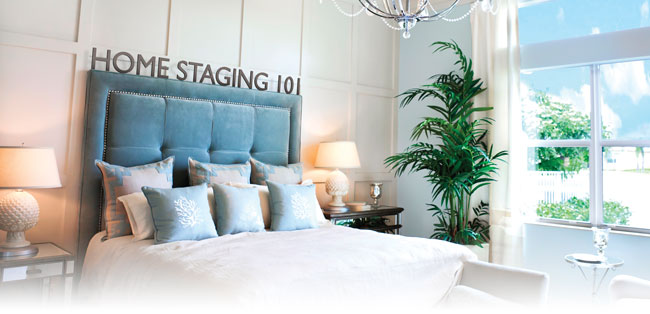Home staging is one of the most powerful ways to make buyers want to buy your home. It can be as simple as de-cluttering and repainting. Or it can require a clean sweep that involves storing belongings off-site; redecorating, and even renting furniture and art to make your place show well. Here are the basics of staging each room in your house, including your outdoor spaces.
1. Go Outside In, and Inside Out
The front porch and walkway give buyers their first impression of your home. House hunters often scout out neighborhoods and drive by listings before they attend open houses.
- Repaint your front door in a focal point color that contrasts and coordinates with the color of your house and other trim. The classic choice: red.
- If the front door knocker, knob and other hardware are worn, replace.
- Make sure stairs and handrails are in good repair, with no rough paint or wood.
- Try to set up a welcoming bench or all-weather chair where visitors can gather to discuss your house.
- Use seasonal decorations sparingly—but use them. Your goal is to help buyers envision their lives in your house. Nothing evokes potential memories like classic holiday icons such as lighted trees, pumpkins, and spring wreaths.
The view from inside the house can frame the best attributes of your yard.
- What is the view from key windows in the house? What do you see from the window above the kitchen sink or the biggest window in the living room? If you can, create an outside focal point to draw buyers’ attention to landscaping. For example, plant red or orange flowers deep in the yard where they will naturally draw the eye of someone glancing out from the kitchen window.
- Likewise, if the view from key windows is less than pretty, screen it with inexpensive lattice.
- Make sure sidewalks are free of clutter, debris, toys and yard gear.
- Fix fences and gates.
- Keep gardens tidy and the lawn mowed.
- Plant full-size, bright annuals for immediate color. Don’t buy small starter plants; they will look scrawny and won’t bring any color to your landscape. Aim for a robust, full garden that implies there is no work for buyers to do, at least in the short run.
2. Declutter and Clean
Decluttering can be daunting. After all, you’re still living in your house. You might need your stuff! Decluttering is not converting your house to a campground. It is selectively pruning anything that distracts buyers from seeing what they are getting with your house.
Here are some tips for decluttering room by room:
Kitchen
- Clear counters of small appliances.
- Keep towels and potholders in drawers, not dangling from the oven handle.
- Corral sponges and cleansers in a shallow bowl under the sink.
- Pack rarely used appliances (crockpots, fondue pots, roasters), tools and pans (see you later, Bundt pan!)
- Collect teacups, plates, pitchers, molds or anything else? Pack away all but a few. Leave up a handful of strategically placed accessories to call buyers’ attention to the decorative shelving.
- Pot racks, utensils hanging on walls and other open kitchen storage can be unsightly and even dangerous, if people are in danger of hitting their heads or brushing up against sharp gear. Take it all down and swap in plain wallboard.
- Pack away rarely used staples and gear like seasonal cookie cutters, extra aprons, and unusual spices to air out pantries, drawers and cabinets. People need to envision their own stuff in the storage spaces.
- Remove evidence of problems, such as ant powder, from closets.
Bathrooms
- Corral prescription drugs in a child-safe area or, better yet, secure them in a different location to keep them from harm’s way.
- Find a different or temporary home for jewlery, perfume, and rarely used toiletries.
- Pack or toss all but three changes of linens to create an airy look in your closets.
- Refresh shelf and drawer liners.
- Remove evidence of mothballs.
- Corral cleaning gear in a single, child-safe spot.
- Clean and repair grout.
Bedrooms
- Pack out-of-season clothes and linens and store off-site.
- Choose a pretty, light set of linens for each bed, with crisp decorative pillows. Now is the time to wash comforters, duvets and quilts so they glow.
- Keep only a couple family photos on display. Pack the rest and secure off-site.
Living, Dining and Family Rooms
- Edit your book piles. Clear away all but a few volumes: what you’re currently reading, and perhaps a few for accessorizing.
- Clear out stacks of magazines and hobby materials. Stacks, even if neat and straight, add weight and visual clutter to rooms.
- Is there sufficient lighting for reading and tasks? Rearrange lighting to ensure that the rooms are well lit at any time of day or night.
- Clean the window treatments and the windows. If your window treatments involve numerous layers, consider leaving only the decorative layer.
- If your walls are covered with attention-grabbing artwork, shrink your arrangement to a tasteful few.
- Examine walls and woodwork for dirt and chips. Will cleaning be enough, or do surfaces need to be repainted? Ditto for switchplates.
- Choose only a few pillows for accents. Ditto for tables and shelves holding collections.
- Reconsider throw rugs. The last thing you want is for a throw rug to throw a potential buyer, figuratively or literally. Either secure them with floor grips, or pack them away.
- Make sure you have a safe, consistent landing spot for TV and sound system remotes, far from the hands of children.
- Limit the number of toys kept in any room, and create a place where the remaining toys can quickly be collected, such as a large basket. If you have a baby or toddler, consider laying a large, light blanket on the floor as a temporary play area. When it’s time to tidy for a showing, you can just gather the four corners of the blanket and voila, the toys are collected and can be plopped in a basket or box.
High Traffic Areas
- Front halls set the first impression. Yours should offer an obvious spot for setting down purses, umbrellas, totes and coats.
- Remove out of season gear from the hall closet.
- Make sure the doorbell and entrance systems (locks and security systems) work smoothly and consistently.
- What is the view from the front door? Remove extraneous furniture so the sightline is as long as possible. The more of your house that visitors can see from the front door, the more intrigued they will be—and that will draw them into the house.
- Remove hooks and hanging things from halls, especially if the halls are used as storage for coats. The hall will seem narrow and even dangerous to visitors who are dodging hooks as they walk through.
3. Focus on Functionality
Nobody is fooled by clever staging that camouflages worn-out appliances and systems.
if you are not sure that all electric, plumbing and structural work complies with municipal codes, request an inspection. If you have to bring your house into code compliance, better to do so on your own terms with contractors you choose, than to have compliance forced on you in the midst of negotiating the sale.
If your appliances are more than 10 years old, they might look outdated, even if they are perfectly functional. Tour a few open houses in your area to see what finishes and functions are commanding top price. Focus on the basics: a high quality stove, refrigerator, dishwasher, and solid faucet. Don’t get carried away with gimmicky add-ons such as built-in espresso makers, which are costly and have limited appeal. You will probably not get your money back on those.
4. Make It Inviting
Your goal is to help potential buyers envision your house as theirs. To do that, they need to see the details of your house. To do that, they need to spend time in it. Your goal in staging is to entice visitors to linger in each room so they can absorb its features and see its benefits.
- Consider the view from each doorway. How can you encourage visitors to step in each room? A small scenario often works, such as an arrangement of an easy chair and lamp that is partly visible from the door.
- Fresh flowers only partially visible from the door will entice visitors to enter the room.
- Make sure seating is arranged so it is open to visitors, not with backs to them, which prevents them from entering the room.
- If your furniture is badly outdated or worn, consider storing it and bringing in a few bright, clean rental pieces.
5. Stage a Friendly Walk-Thru
Unless you are a rigid minimalist, you probably have quite an accumulation of things if you’ve lived in your house for any period of time. Pictures, books, accessories, knickknacks, small appliances, toys, pet gear, hobby materials… The piles can seem endless.
Get a friend whose decorating taste you admire to tour your house with you and give you constructive criticism about where you need to pare back. Your goal: to help buyers see the house you are selling. Any furniture or decorating that prevents them from seeing the best features of your house should be your first staging priority. For example, the master bathroom might have classic fixtures and cabinetry in excellent condition…that buyers look right past because they fixate on the tropical-fish shower curtain you purchased as a vacation souvenir. Fun for you, but a distraction when selling the house.
Ask your friend for a no-holds-barred critique. Then, put the free feedback to good use.






